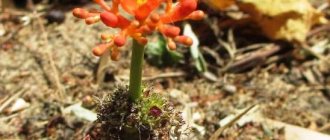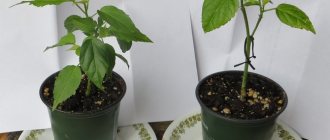The Cattleya orchid is a perennial flowering plant of the Orchidaceae family, the size of which can reach up to one meter in height. Plants that are representatives of this genus are popular in floriculture. Orchids can be grown both at home and in greenhouses and botanical gardens.
She is referred to as the queen of orchids. This is all because its color is not limited to one color, it is characterized by a wide palette of colors. It also has a delicate aroma and an unusual flower shape.
History of the genus Cattleya
The flower is native to South and Central America , where it was first discovered by Europeans in the early 19th century. This genus was named after W. Cattley, who was the first owner of a collection of orchids in England. Cattleya has spread widely throughout the world.
These flowers can be seen growing both on the branches of trees in the humid jungle and on the slopes of mountain systems where the temperature drops below zero. This plant quickly gained popularity due to its unusual flowering and leaf shapes that others do not have.
Over two centuries, the orchid has not only not lost its relevance, but is still in great demand as home decor. Since Cattleya is considered an expensive and sophisticated accessory in America and Europe , it is also used to decorate evening dresses.
How is it different from other orchids?
As a rule, all species in the same genus have a common feature, but the Cattleya group is replete with extraordinary diversity. Varieties with small buds can boast a large number of flowers on the arrow, while large ones, on the contrary.
This is interesting: the exotic orchid is very popular among artists of various genres. Martin Johnson Head (1819–1904) is considered a great connoisseur of Cattleya. Five of his paintings with epiphytes are known.
It has hard and dense leaves to the touch, which indicates its love for light. But it should be remembered that direct sunlight is destructive for such gentle beauties.
The petals are wider than the sepals or have the same parameters. The column is long and round in cross-section. The arrow is formed at the top of a new shoot growing from a pseudobulb, with 2–3 internodes.
Kinds
According to various sources, there are from 40 to 130 species of Cattleya orchids in the world. Despite this diversity, they have common characteristics. For example, the ability to extract water from the air is due to numerous creeping roots. Cattleya flowers, when cut, do not fade for a long time, even in the absence of water .
Another characteristic feature of all orchid plants is their structure. The flowers have brightly colored sepals and three larger petals.
Some of the most common types are described below.
Hybrid
It received this name because of the large number of hybrid forms obtained by crossing different species and varieties.
Orange-red
Plants of this species have from two to ten fiery orange buds. Also distinctive are the spindle-shaped stems , which are quite thin at the base, but gradually thicken towards the apex. The inflorescences are on a shortened peduncle.
Forbes
This species can be recognized by its thin, cylindrical or spindle-shaped stems, which can grow up to 30 cm in length. The leaf blades are oblong and obtuse. Buds can be counted from two to six. Their colors vary from olive yellow to light chestnut.
Lubby
He is the founder of the genus . The bulbs are fusiform and unifoliate, covered with gray-green scales. The leaves, like those of the previous species, are obtuse and oblong. They reach a length of up to 14 centimeters. Can be recognized by its pinkish or lilac buds.
Detailed description
If you have a vague idea of what the most beautiful orchids look like, a photo of Cattleya will demonstrate a true miracle. The perennial belongs to the category of beautifully flowering ones. All varieties of this genus are conventionally divided into several types: single- and double-leaved. Professional flower growers recommend growing specimens with a pair of plates in the house. They are less demanding in care. Flower shops sell mainly hybrids distributed for the spring and autumn growing seasons.
One of the most beautiful types of orchids has different bud sizes - from incredibly small to the largest in the family. The color palette is replete with a huge variety of shades - from snow-white to dark purple. The lip always differs from the sepals in shape and stands out brightly against their background in color. Most subspecies have an incredibly strong aroma that lasts all day.
In the central part, the plant has a thickening called a pseudobulb or small false bulb - up to 15 cm. The average length of epiphyte leaves reaches 30 cm.
Is it a poisonous plant or not?
Orchids are one of the most popular plants in cooking, folk medicine and cosmetology. There are only a few varieties of orchids that are not beneficial and can even cause harm. These include exclusively tropical varieties:
- Wanda.
- Cymbidium.
- Sarcochymus.
The Cattleya orchid is considered a delicate and fragile beauty that will decorate a home or garden. It is completely harmless and will delight you with a pleasant aroma and bright colors.
Landing
The most important thing for planting is to use bark and sphagnum moss as a substrate .
First, the components need to be soaked for several days. This is done for better moisture retention. Then all the ingredients are crushed and polystyrene foam and perlite are added to the mixture. Cattleya should not be replanted unnecessarily, because the plant does not tolerate planting and handling well. She only needs this procedure when the potty becomes crowded. If you do not replant it at this moment, the orchid may die. The best time for replanting is spring, when shoots on the bulbs begin to form.
Landing is carried out in the following order:
- First you need to prepare a florarium.
- Place a small layer of stones on the bottom.
- Add crushed bark as a second layer.
- Place a thin layer of sphagnum moss.
- Only now place the orchid, lay out a layer of substrate and secure with thin sticks.
Cattleya can also be grown in a pot, but you need to choose it carefully. You should not buy small pots to avoid frequent replanting of the plant. You need to pay attention to ventilation. An orchid loves air and can die if there is not enough air. It is better to opt for ceramic or plastic flower pots.
LiveInternetLiveInternet
Monday, May 28, 2012 11:08 + in the quotation book Legends of Flowers. Cattleya.
In 1817, botanist William Swanson, while on a business trip to the province of Pernambuco in northern Brazil, explored the local flora, and, pleased with the new finds, sent several specimens of mosses and lichens, obtained epiphytic orchids to the Botanical Garden in Glasgow, accompanied by a request to transfer a separate parcel to the respected colleague, collector of tropical plants and owner of the first orchid collection in England, William Cattleya. Speaking of “crazy” collectors, their weakness for exotic flowers was known in narrow circles, but widely enough that the Cattleya collector quite regularly received parcels from botanists who had visited the tropics of South America. Another package, in which tropical plants (possibly lichens) were wrapped in thick leathery leaves instead of wrapping paper, probably pleased Cattleya, the botanist unpacked it, took out the gifted plants, and folded the wrapping-package into the corner of his greenhouse and, carried away by acquisitions, as often It happens that I forgot to remove the “garbage”. A few months later, or rather in November 1818, Cattleya, to his great surprise, discovered that incredible flowers appeared on forgotten leaves left in a secluded corner - large, unusual, covered with purple specks. The botanist was breathless with amazement when he realized that he had become the happy owner of luxurious exotic flowers with pink petals. Dismantled by emotions, William Cattley could hardly pacify his impatience to share his joy at owning a rare miracle with other connoisseurs of exotic flora, so the first thing he did was invite a famous specialist, John Lindley. A great connoisseur of orchids, Lindley, without the slightest hesitation, determined that Cattleya's plant was an unknown orchid. The sensational discovery immediately spread throughout Europe: for the first time, a tropical orchid bloomed in Europe under artificial conditions (at first glance, not at all suitable, and, to put it mildly, unusual). And already in 1821, John Lindley’s work “Anthology of Botany” (Collectanea Botanica) was published, in which he described a new species of tropical epiphytic orchid and gave it the name Cattleya maxima. As it turned out later, this species of cattleya was not the first to be found: long before the episode, namely back in 1777, Spanish botanists, while on a forest exploration expedition organized by the government, sent home a valuable parcel with unfamiliar orchid flowers found in logging sites on the border of Peru and Ecuador. But the herbariums of botanists were delivered and printed too late, only in 1831, when Lindley had already published his work describing a new species and a new genus of orchids. But the parcel contained a different species of cattleya - Cattleya labiata.
Five years later, in 1836, Cattleya fans learned about the discovery of a third species - George Green, while in Venezuela, showed his findings to his guest, Mrs. Moss, who hastened to make several drawings of the unfamiliar flowers presented and send them to the professor in Glasgow, botanist-systematist William Jackson Hooker. He named the new species of cattleya in honor of Mrs. Moss - Cattleya mossiae. In total, the Cattleya genus consists of 113 natural species of exotic orchids growing in Tropical South America, on the coast of Costa Rica. Until the 1980s, cattleyas were used in orchid hybridization; new hybrid species appeared with flower diameters from 5 to 15 and even 25 cm, in all shades except true blue and black. They were grown for commercial purposes, but for a long time they were not sold as potted plants, but only cut flowers of cattleyas. And only in the late 1980s they began to work on developing cattleya cultures that could grow and be kept indoors directly in pots or flower baskets. Cattleyas were subjected to hybridization not only between species within the genus, but also crossed with adjacent genera of orchids, resulting in so many hybrids that one can easily get confused in the names and classifications: Laelia, Brassavola, Sophronites, Rincholaelia, Potinara, Epidendrum, Encyclia, Euhille, Coilostilis , Prosteshea, Yamadara, Guariante, Myrmecophila - all these are cattleya hybrids, many of which are separated into separate species and even genera. Hybridization of cattleyas can take place with a large number of “parents”; scientists claim that up to 8 parental genera with the same set of chromosomes can participate in the creation of one hybrid, such as Brassavola x Broughtonia x Cattleya x Cattleyopsis x Caularthron x Epidendrum x Laelia x Sophronitis and get Gladysyeeara. In the modern world, the leading breeders of cattleyas are Taiwan, Japan and the USA.
But not everything went smoothly: amazing orchids did not reveal the secrets of their reproduction to collectors for a long time. The smallest seeds in the plant world - cattleya seeds - received the sad reputation of being “sterile”, which is exactly how they seemed to botanists. The first success smiled on the English gardener John Dominy in 1856, when the botanist managed to germinate seeds obtained from artificial crossing - cross-pollination of other orchids, not cattleyas, Calanthe masuca x Calanthe furcata. He grew the first artificial hybrid, Calanthe dominii. Over the course of 20 years, Dominy produced about 25 more hybrids, and in 1863 he obtained the first intergeneric hybrid, Laeliocattleya exoniensis (Cattleya mossiae x Laelia crispa). But he was the only successful orchid breeder, until 1909, when the Frenchman Noel Bernard revealed the secret of the germination of orchid seeds: it turned out that for germination the seeds need microscopic fungi, with which they live in symbiosis. Today, the leaders among orchid hybrids are cattleyas: thousands of cattleya hybrids are propagated and sold in millions of copies around the world.
Of the natural species of the genus Cattleya, one of the rarest (and therefore valuable) is Epidendrum ilense, which has an amazing story associated with it: in 1976, logging was carried out in the same Ecuador, abundant in wonderful finds. Engineers became interested in strange vines growing on a fallen tree and urgently called botanists. Upon arrival, scientists discovered only 3 specimens of an unknown orchid. The new species is named Epidendrum ilense. Even without being classified, these orchids were already threatened with complete disappearance from the face of the Earth due to the development of forest plantations. Three specimens of the plant miraculously survived under the tractor tracks and were sent to America, England and France. In the suburbs of Paris, in Boissy-Saint-Léger, epidendrum, with the help of a program of meristem reproduction, not only survived and survived, but even appeared to people in a blooming form... Source
| Categories: | this is interesting aphorisms, parables, legends flowers |
Tags:
flowers are interesting
Cited 2 times Liked by: 1 user
Like share
0
Like
- 1
I liked the post - Quoted
- 0
Saved
- Add to quote book
- 0
Save to links
Liked1
0
Bloom
An orchid blooming is something incredible and beautiful. As they develop, the leaves open and flower stalks appear. The curled peduncle, like a little bag, carries several beautifully scented flowers in a racemose inflorescence. Sheathed flower stalks are already visible or may appear within a couple of weeks after the leaves have fully opened. Their color is different, you can see both a sunny yellow tint and snow-white, which depends on the species .
The exact time of flowering cannot be said. There are autumn-blooming Cattleyas and those with spring bud formation.
Necessary conditions for flowering:
- Cattleya needs sun, so do not grow the plant on the north side.
- It is important to water the flower regularly. In summer, the soil needs to be moistened 2-3 times a week and placed under a warm shower once a month.
- It is also necessary to provide fertilizing. This can be done by adding fertilizer to the water for irrigation. The fertilizer must contain phosphorus and potassium. You need to stop feeding after the formation of buds.
Mistakes in caring for Cattleya and their elimination
If there are errors in maintenance, the plant begins to hurt and may even die. Therefore, you need to know what the pathological condition of the orchid is associated with in order to eliminate the shortcomings in a timely manner.
| Symptoms | Error |
| The peduncle dries out without producing buds. | Lack of light, moisture or fertilizer. |
| Foliage and bulbs turn yellow. | A burn has been caused. |
| The foliage changes color to dark green, the blades become softer and droop. | Lack of lighting. |
| The tips and edges of the leaves dry out and turn brown. | The room temperature is too high. |
| Peduncles have stopped developing, only new shoots are formed. | The flower is too young (it has three or fewer pseudobulbs) or the orchid is not watered correctly. |
| The bulbs at the base turn black, it seems that they are wet. | Excess moisture. The situation is aggravated at low temperatures and drafts. |
Growing conditions
The Cattleya orchid is considered a very whimsical plant. In order for it to develop intensively and bloom, it needs to create the following conditions :
- The best place is on the windowsill, but avoid the north side if the flower is at home. In summer, it is better to take the pot out onto the veranda or balcony.
- The lighting should be bright. Morning and evening sun is quite safe for the plant. For illumination, you can use phytolamps, since regular leaves can change their color to purple.
- During the growing season, the temperature should be between 22ºC and 30ºC. It is recommended to ensure a small temperature difference between night and day time.
- Air humidity is one of the most important criteria. The optimal humidity is 60-80%. In the warm season, it is advisable to spray the air around the flower.
How does it reproduce?
The plant propagates by dividing the bush if there are 8-10 bulbs.
To properly propagate a plant, you need to know the sequence of the procedure.:
- First you need to prepare new suitable pots. Fill them with substrate and place them in a container with warm water.
- The roots of the plant must be cleaned.
- Prepare the tool and carefully divide the bush.
- Place the resulting roots in different, pre-prepared pots.
Reproduction methods
Cattleya is propagated by dividing the bush and by children. This is done extremely rarely with seed, since seedlings are difficult to grow and the wait for flowering is long.
An adult orchid bush is divided and placed in different pots. This happens as follows:
- The plant is watered abundantly and left for three to four hours. When the soil is completely wet, the orchid is carefully removed.
- The rhizome is washed well with warm water, and the remaining soil is removed from the shoots.
- The bush is divided into parts using sterile instruments. Each division has from 3 bulbs and living roots. The cut areas are treated with crushed charcoal.
- New bushes are planted in separate pots.
Cattleyas are characterized by the formation of children. When they are not there, it is recommended to use cytokinin paste to stimulate growth. Reproduction occurs like this:
- The daughter shoot is carefully cut from the mother bush. The baby is taken to be quite developed, has living roots and several leaves.
- The sprout is soaked in Kornevin for several hours.
- The shoots are planted in a pot with bark and moss.
- The recommended temperature is maintained in the room (+22…+30 ºС), diffused light is created, and the soil is moistened.
Cattleya orchid plant propagation
Diseases and pests
An orchid can be attacked by the following types of pests:
- Shield . Looks like dark spots on the leaves. The plant needs to be treated with insecticides.
- Whitefly . Yellow spots appear on the leaves, leading them to die.
- Mealybug . Appears in dry air. It can be removed using insecticides or a soap-alkaline solution.
The Cattleya Orchid is a very demanding plant that requires special and constant care. When starting such a flower, you need to think about the conditions that will meet the needs of this capricious individual. You need to show patience, love and care for your green pet. Then the plant will give you a great mood, a pleasant aroma and a riot of bright colors.
Prevention
All problems associated with cattleya arise due to improper handling of the epiphyte. Although hybrids are adapted to apartment conditions, the plant will not survive without human care. It is enough to follow all the recommendations for caring for an orchid of this genus that we have shared.
This unique beauty can fascinate anyone with its exoticism, especially during the flowering period. It is characterized by an easygoing disposition, which is why they prefer to grow it at home. The main thing is to pay attention to the green pet in a timely manner and not to overdo it.











